Once again Google has updated their Search Quality Raters’ Guidelines. As we do each time this happens, the MHC team has spent time analyzing what has changed. In this article we will discuss what we think are important changes in the document and how we, as SEOs and website operators, can take advantage of this new information.
Why does it matter that the QRG have updated?
Historically when the QRG update, there have been significant Google algorithm updates that follow. In our opinion, often those updates reflect changes that have recently been made to the QRG. This makes sense when we stop to think about why the QRG exist. The purpose of this document is to train an army of tens of thousands of individuals to manually assess page quality. If the Google engineers want to make a change to the algorithm, they will show the new SERPS to the Quality Raters and have them assess the websites that appear on those searches. It makes sense to us that if something has changed in the wording of their manual, this means that the Google engineers either want to refine the explanation of a particular aspect of quality, or, they want to add new information that could be used for quality assessments.
The last time the QRG updated was July 23, 2018. While there were many changes in the document at this time, the most important, in our opinion, was the addition of three words, “safety of users”:

There were other changes in the document that all centered around the concept of measuring trust and safety. We felt that many of the changes introduced with Google’s Medic Update (August 1, 2018) and also the update on September 27, 2018, happened as a result of Google turning up the dial on trust, the “T” in E-A-T. The majority of the sites we have analyzed for traffic drop assessments following those updates had trust issues that were clearly defined in the QRG.
As such, with this update of the QRG, our goal is not to tell you what changes we think can give us clues to what Google wants to assess in terms of quality.
Do the QRG even matter? Do they really reflect what is in the algorithms?
We have maintained for over two years now that anything that is in the QRG is something that is either already being algorithmically determined by Google, or, is something that Google wants to deal with in their algorithms.
Google’s VP of Search, Ben Gomes, said the following in an interview with CNBC:
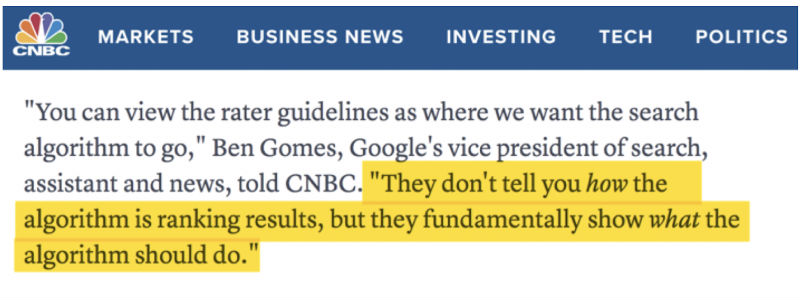
We have written plenty in the past on E-A-T (Expertise, Authoritativeness, and Trustworthiness), including an article on whether or not E-A-T is a ranking factor (spoiler alert...we’re positive it is!).
Now we will look to see what has changed in the QRG update on May 16, 2019, and how we can potentially take advantage of this information.
Interstitials
We all know that Google is not a fan of interstitial ads, especially on mobile. The following words, highlighted by us, have been added to the section in the QRG on Deceptive Ads:

The example link points to this Google blog post:
https://webmasters.googleblog.com/2016/08/helping-users-easily-access-content-on.html
It is interesting that Google added the words “interstitial page” to this section. We do not feel that this is a significant change though as Google has had an algorithm for several years now that is meant to demote sites that present users with an interstitial ad immediately upon arriving from search.
We think there are two possible reasons why these changes were made:
1) It may be that some of the Quality Raters were not understanding that a full page interstitial was the same as a “pop-over Ad”. This could just be more clarification.
2) It could be that these words were added because Google wants to improve upon the interstitial ad algorithm and is looking for more specific feedback from the raters. This algorithm does not appear to work well as many sites appear to be still ranking nicely despite using mobile interstitials. Perhaps this will change soon!
Every Day Expertise
One of the questions we are frequently asked is whether authors truly need formal expertise to be seen as having high E-A-T. In many cases, the answer to this is yes. If a searcher is looking for information because they have recently been diagnosed with a rare medical condition, while every day expertise can be useful, the most trustworthy info likely is going to come from a medical practitioner who has regularly treated this condition.
However, in some cases, real life experience potentially can trump degrees and official qualifications.
The highlighted section below was added to the QRG:
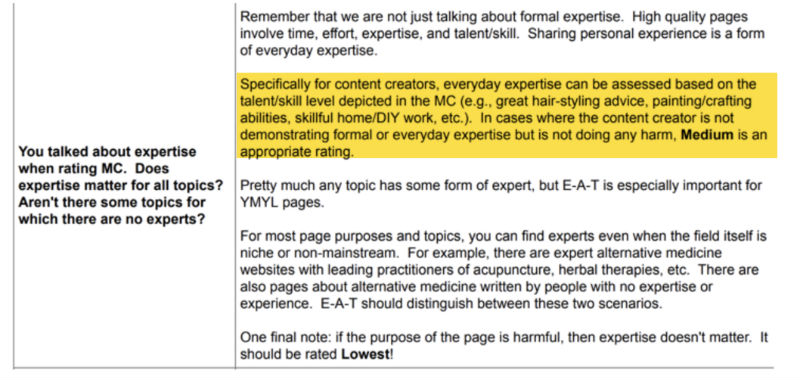
Note though, that the raters are told to use a rating of “Medium” for a content creator who is demonstrating expertise in a way that is not formal. This rating is also provisional on the fact that the article is not going to cause users harm.
Does this mean that E-A-T is being softened as a ranking factor? We do not think so. Rather, we think that Google may be working on developing better signals for evaluating the E-A-T of content creators for queries for which formal training may not always be the best indicator of expertise.
It would not surprise us if a future core quality update allows more sites with hobbyists or non-formally trained authors to rank better for queries that aren’t specifically YMYL.
Are Quality Raters assessing voice search?
We thought this addition to the instructions for the raters was interesting:
![]()
It may be possible that the Quality Raters are going to be assessing the quality of results on voice search. Or, it could just be that they want the raters to assess page components such as widgets, videos and tools that use sound.
Some interesting changes in examples given
The QRG are full of real life examples of pages that are to be considered either high or low quality. In most cases, those examples have not changed. However, we thought the following changes were worth discussing.
It is interesting to see that Google added the highlighted words below:

We believe that in this example Google is emphasizing that reputation and E-A-T are all a part of page quality. (There will be more on page quality later in this article.)
In this next example, a few more words on reputation were added and modified.
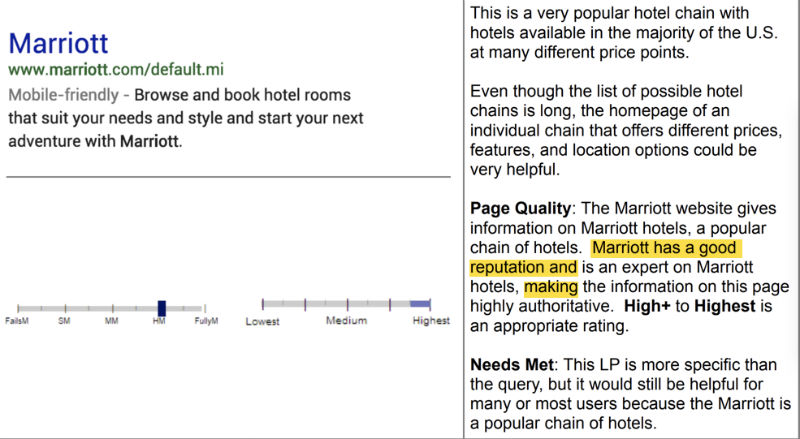
We thought it was interesting that this wording used to say, “and the information on this page is highly authoritative” rather than, “making the information on this page highly authoritative.”
This may seem like a minor change, but in our opinion it tells us why it sometimes happens that a less than helpful page can rank well. If you are competing against Marriott hotels and trying to rank for people who are searching for that brand, even if you have written an incredibly helpful and thorough guide that is much more informative than what is on Marriott’s own site, it probably will not outrank them. This is because the brand is extremely authoritative.
We do not write this to discourage our readers from writing “best of its kind” content. Rather, we would encourage you to consider what users expect to see when typing in their search query. If you are trying to capture searches for “marriott hotel toronto”, or “what time is checkout at the seattle marriott”, it’s going to be hard to rank against the official brand’s site even if your pages are more helpful to searchers.
Here is another example in which words were added to emphasize the importance of reputation and good E-A-T:
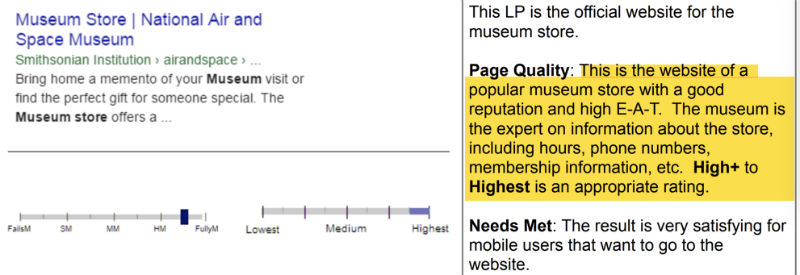
Huge Emphasis on Page Quality
The most interesting change made in this revision of the QRG is that in many places, they have replaced the acronym E-A-T with the words, “Page Quality”.
All of the highlighted words below used to say, “E-A-T”:
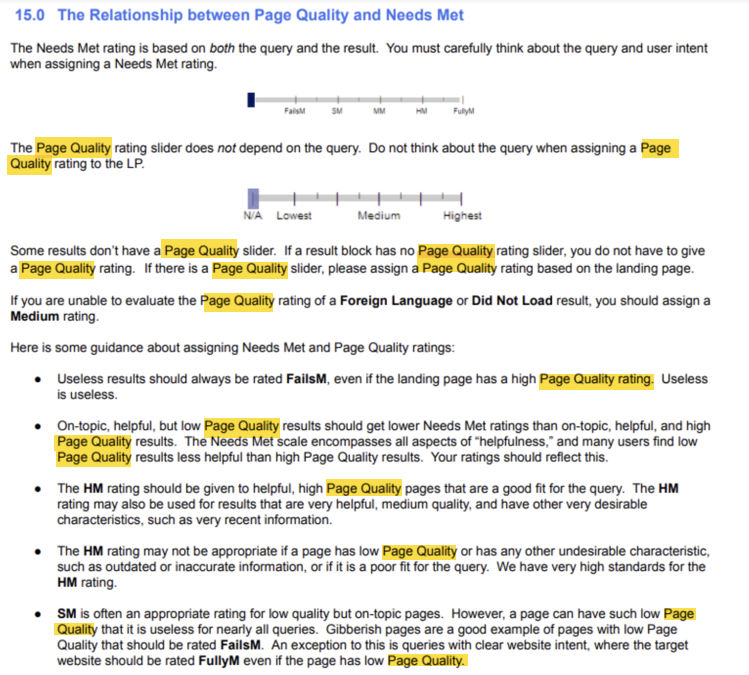
Many of the examples given have replaced the words “E-A-T” with “Page Quality” as well.
Old version:
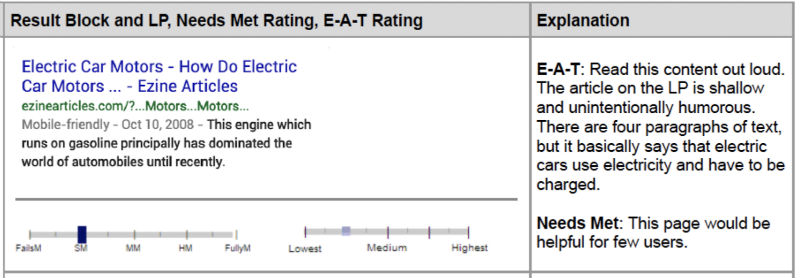
New version:
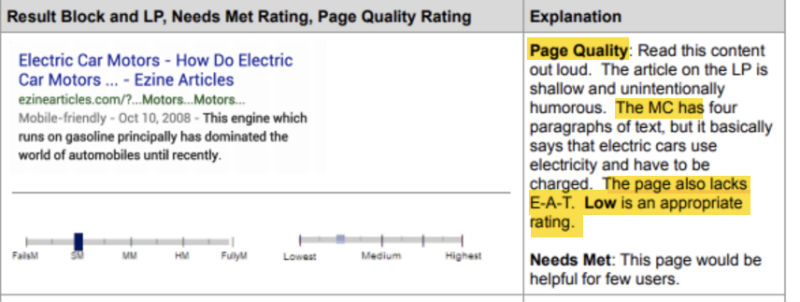
We do not think that page Quality and E-A-T are completely synonymous. Otherwise, it would not make sense in the above example for Google to add, “The page also lacks E-A-T.”
Our predictions for upcoming algorithm updates
We think Google is going to put even more effort into determine the quality of the content on pages. Previous versions of the QRG seemed to be primarily focused on determining the E-A-T of the website and/or its authors. While these are still important factors, this switch in terminology to use “page quality” rather than “E-A-T” when discussing on-page quality likely warrants our attention.
Why did Google formerly interchange E-A-T and Page Quality as terms? The sections that define E-A-T have not changed.

E-A-T is still important! The Raters are still told to put a lot of emphasis on determining E-A-T signals when assessing quality.
We have spoken in the past about Google search patents that talk about using “trusted seed sites” as a way to determine which links to count as valuable. Our theory is that links from sites with good E-A-T pass full PageRank and that links from sites that are lacking E-A-T signals either pass less PageRank, or possibly are not even counted towards rankings at all for YMYL queries. If this is true, it may make sense that in some cases Google is relying too heavily on the strength of the E-A-T of authors and brands in order to determine the quality of the actual content on the page.
Right now, E-A-T is likely based mostly on authoritative mentions of the website or the author of the content. We expect that in the future, some sites that have managed to find ways to be much more valuable than high authority competitors may start to rank better.
Let’s see what happens! We are betting a big update will happen very soon.
If you are interested in having the MHC team assess your site in terms of E-A-T and page quality, you can find information here on our site quality reviews.



Comments are closed.